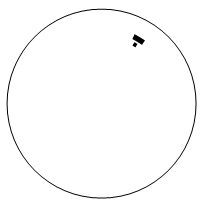Soviet IFF system Kremniy-2
система опознавания Кремний-2
Identification, friend or foe
Overview
Kremniy-2 is a Soviet system for identification, friend or foe (IFF), which was probably developed in the 1950s. The signal of an interrogating station must be answered with the correct code. For the code, there are 12 possibilities that are modulated to the response signal. The security of the system is based on the secrecy of the then valid code that was changed in hours.
Kremniy-2 uses three frequency ranges:
- Frequency range I: primary radar 8600..9700 Mcs
- Frequency Range II: Primary radar 2520..3380 Mcs
- Frequency Range III: Interrogation and response frequency 668 Mcs
/1/
The frequency range II was put out of service by the East German forces in the early 1980s /12/
Interrogation
There are three interrogation modes in which the interrogation signal is sent on one or two frequencies. When making an interrogation on two frequencies, the signal of the primary radar is jointly used, to which the IFF system is coupled.
Interrogation modes according to /1/:

I assume that „Interrogation 3“ is the so-called "Autonomous Interrogation", because it can also be used independently of a primary radar (although the synchronization with the primary radar is still needed to ensure a consistent presentation).
On the screen, a target with IFF is shown by a parallel bar on the far side /1/, /3/, /8/
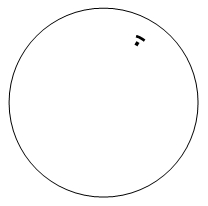
The pulse lobe of the secondary radar is generally wider than that of a primary radar. If both are used together and Kremnij is interrogated with three pulses, "birds" form on the radar screen.
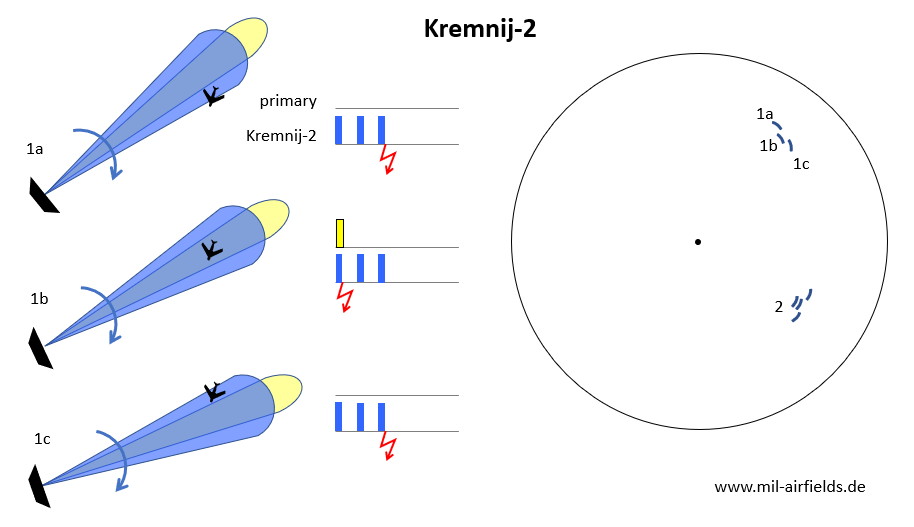
1a: Initially, the target is only hit by the wider Kremnij interrogation lobe. The transponder on board responds after receiving the third impule.
1b: When the antenna has rotated further, the target is now hit by both the wide Kremnij lobe and the narrower primary radar lobe. The transponder now reacts already after the first pulse, which arrives at the same time as the pulse of the primary radar.
1c: When the antenna has turned further, the target is now only in the zone of the wider Kremnij lobe. The transponder now responds only after receiving the third impule.
In the case of 1b, the echo of the primary radar coincides with the Kremnij response. In contrast, the responses at 1a and 1c are given about 10 microseconds later, which corresponds to a distance of about 1.5 km. Therefore, these Kremnij responses are displayed on the radar screen as correspondingly further away. The result is a structure that looks like a bird.
Apparently there were ways to delay the Kremnij response signal before the display. If this was used, the entire Kremnij response was displayed as further away - see figure 2 above.
Source: /13/
Mode I: General identification (frequency range III) - Режим I
First, there were 12 frequencies which can be used to code the response signal /1/
| 1: | 1,67 Mcs | 7: | 5,67 Mcs | |
| 2: | 2,33 Mcs | 8: | 6,33 Mcs | |
| 3: | 3,00 Mcs | 9: | 7,00 Mcs | |
| 4: | 3,67 Mcs | 10: | 7,67 Mcs | |
| 5: | 4,33 Mcs | 11: | 8,33 Mcs | |
| 6: | 5,00 Mcs | 12: | 9,00 Mcs |
In discussion forums, it is occasionally discussed whether there have been 12 more code filter for war time use /4/, /5/
Pulse diagram of the response signal according to /1/:

It seems that there was a change over time: /3/ specifies 36 possible codes, which consist of only 6 different frequencies, but with 6 additional combinations for the time positions T1 and T2 of two following response codes:

In /11/ there is a hint that also indicates a variable timing of the response code: This manual states “numbers of the pulse intervals”.
Check Code - Режим контрольного запроса
(Other names: Kremnij-2M /2/, 81Э or 81Ä, Interrogation K, Additional Code)
The response signal of the system Kremnij-2 can easily be imitated by an enemy, because there are only 12 different codes. Therefore, the possibility of a check code / additional code was introduced (in the East German forces in the early to mid 1980's /12/) The reaction to the check code interrogation must by activated manually at the transponder (e.g. by the pilot of the aircraft), triggered by a code word sent over the radio. When the check code is interrogated by an additional fourth pulse, an activated transponder recognizes this pulse and doesn't send a response. Only the imitation units of the enemy continue to answer and are still shown on the screen with an IFF signal.
Pulse diagram of the query according to /3/

Using the check code was only allowed when it was ordered /10/, presumably to keep the system secret until war time.
Veterans say that the check code in planes could be turned on and off, but without additional coding /4/ /5/. Perhaps this has changed over time: /11/ from the year 1990 says "changing code of the check code of aircraft" and directs to use code no. 0 for the check code until different order.
Mode III: Individual identification (frequency range III) - Режим III
The individual identification has one additional pulse that follows the general identification. This additional pulse can have two positions in time, so there are two possible codes. Pulse diagram of the individual identification according to /3/:
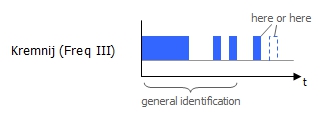
This signal seems to correspond to the SPI ("ident") of the civilian secondary radar.
I also found other information about the individual identification:
- The individual identification was displayed on the screen in the form of Morse code or letters /5/
- To set up the individual identification, a three-digit code is used /11/
These may date from another time or refer to the Parol system.
Distress Signal
For the distress signal, the frequency-coded signal of the general identification is repeated. Therefore, the distress signal is bound to the correct setting of the code frequency, i.e. when the code is set incorrectly, the distress signal is not shown on the radar screen.
Pulse diagram according to /1/ /3/
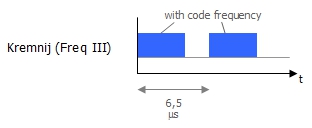
A target with distress signal is shown on the screen with a bold bar /3/, /8/
